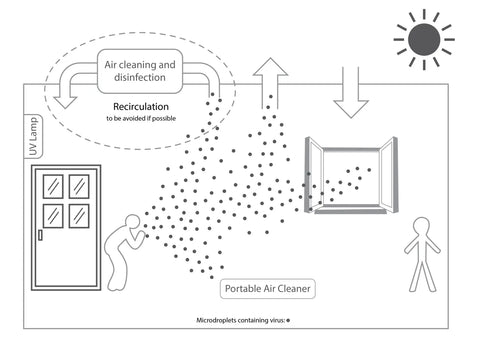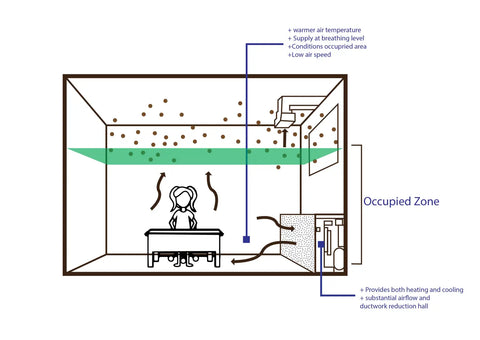No Products in the Cart

Navigating a school reopening can be daunting. It is unprecedented and unpredictable. School leadership, though, is being called to have all the answers to questions such as:
“Is it safe?”
“Is it too soon?”
“How can we be sure?”
The truth is, there are so many things leaders cannot know for sure.
But we have learned some things over the past year, and the one thing that is very clear is that we need safer, healthier school environments. Schools everywhere have been upping their game on encouraging hand washing, covering coughs and sneezes, and social distancing.
But what about the air itself? The pandemic has made it clear that our 40-year-old (or older!) air filtration systems just aren’t making the cut anymore. According to the CDC, the coronavirus can be spread via airborne particles. That means the very air you breathe can be infected.
This is where ventilation is failing us. And this is also why we have developed this guide to school ventilation, to give leaders some of the answers they need about how to keep students and staff safe in a post-COVID world.
Older air filters do not have the ability to filter out airborne viruses as well as newer filters do.
Better air filters can drastically decrease the spread of airborne viruses or viral droplets by decreasing the actual number of viral particles in the air. We lower the risk by lowering the chance of exposure. Once you are exposed, then you can be infected. If you are never exposed, then you cannot be infected. Makes sense, right? So by improving ventilation, we decrease the chance your body even gets exposed to the virus.
But what if we don’t change the ventilation systems? What's the worst that can happen? The simple answer is: a lot! Poor air quality can lead to the following consequences, according to the Environmental Protection Agency (EPA):

School closures. As we saw in 2020, disease outbreaks in schools can lead directly to school closures. But also think about what could happen if the entire ventilation system breaks. We cannot have children in school without proper ventilation, so the school would need to close. Getting the ventilation system repaired and up-to-date with high-quality filtration systems is absolutely essential to keeping our schools running and keeping kids in the classroom.
Costly repairs. Not only could the school be shut down if the ventilation system breaks or if there is a disease outbreak, but your school could also incur costly repairs. Getting high-quality and health conscious ventilation systems installed will be necessary someday. But waiting until it completely breaks, would mean disaster. Then, you will have to scramble to find one that meets the latest standards, and have to pick whatever system you can get installed the quickest. There will be no time for finding the best deal or even truly the best quality. Waiting until it’s necessary will put your school in a bad spot, so start looking for your new ventilation system now!
Chronic health conditions. As a school, you live for your students. You stay up late, skip lunches, and sometimes even donate your own money to be able to help your kids. The last thing you want is for the very air they are breathing to hinder their success. But that could happen. The Environmental Protection Agency (EPA) states that air quality - along with other aspects of the school’s physical environment - can negatively impact students’ attendance and academic performance. Additionally, poor air quality can affect you and your staff members. The EPA reports that poor air quality can affect teacher/staff productivity and retention. Working in an environment where the air is constantly stuffy, dusty, and dirty is not good for the energy levels and general health of everyone at your school. This can lead not only to decreased satisfaction amongst students and staff, but also negative publicity and liability issues.
At the end of the day, it’s about your students’ safety and success. Having a plan for optimal ventilation in your school is essential to keeping your kids healthy and ready to learn.
Ventilation is all about air flow and cleaning the air. Even in the oldest of school buildings there are things you can do to improve the ventilation in your school. The Center for Disease Control (CDC) recommends the following ways to improve ventilation in schools:

Open windows. Maybe the easiest thing your school can do is to open the windows, at least when the weather is nice out. Depending on what part of the country you are in, that might not be very many days, but still have a plan in place to get the windows open whenever possible. Make sure there are safety measures in place such as safety bars or windows that open only a small amount. That way, on a nice day, teachers can feel free to open the windows without fear that the children will climb or fall out. Make it as easy as possible for those nice days to improve ventilation.
Use fans. Fans are a great way to increase the air circulation in the room and move those airborne particles out. When putting around students and staff, though, make sure the fans are secured to reduce risk of injury.
Move your classroom outdoors. Encourage your staff to move their classrooms completely outdoors whenever possible. Give out a guide to teachers about when they could move class outside. Some examples include: reading time outdoors, physical education on the playground rather than in a gym, biology class outdoors to learn about the local ecosystems, or history class outdoors for a reenactment or demonstration. Giving your staff a few ideas of when to move class outdoors can greatly reduce the stress of having to rewrite their lesson plans...again. Help them modify the lesson they already had planned for an outdoor setting.
Use exhaust fans. One of the simplest ways to increase ventilation in your school is to encourage the use of exhaust fans. Bathrooms can be stuffy and poorly ventilated. They often do not have windows, especially not ones that open. Not to mention they are already high-germ areas. Putting up signs around your school to encourage students and staff to turn on exhaust fans when in the bathroom can improve your ventilation without costing you a fortune.
Get the most out of your HVAC. All the tips above are great ideas on a nice day. However, most days are not going to give you that luxury. It might be raining outside (there goes opening the windows and moving outdoors!), too hot, or too cold. Sometimes the fans can be too loud or distracting for the students, or maybe there is just no good place to put them. The one thing you can always count on, though, is a good indoor ventilation system. That’s why the number one way to improve ventilation and keep your students safe is to look at your current system and make sure you are maximizing your school’s air quality.
With all the settings, numbers, standards, and who knows what else that are available on your HVAC, how do you know what settings are the best? According to the Center for Disease Control (CDC), these are some of the ways you can ensure you are maximizing the air quality using your HVAC:

Use top quality air filtration. The type of filter you use can make a big difference. Different types of filters are capable of filtering out different types of air contaminants. For example, a high efficiency particulate air (HEPA) filter can filter out airborne particles at a size of 0.3 microns (µm) or larger. This includes mold, pollen, dust, and bacteria. Alternatively, filters that contain activated carbon can filter out gaseous pollutants such as smoke. Know what filtration system is used at your school and where you might need extra protection. Our experts at Cetrix are here to help you through this process!
Use portable air purifiers.Portable air purifiers can provide an extra layer of protection in high-risk areas, such as a nurse’s office where sick children may congregate or in gymnasiums where children are perspiring. Having a few on hand can also help prepare your school for if the main ventilation system breaks. Cetrix has many options of portable air purifiers for your school that can meet your school’s budget.
Use ultraviolet germicidal irradiation (UVGI). For when all else fails, use ultraviolet germicidal irradiation (UVGI) to inactivate potential viral particles. A qualified professional can help you get this installed. The PureMax CAP-500 UVC Air Purifier is a great portable option to use in areas where optimal ventilation simply cannot be achieved.
Make sure you are considering classrooms, nurses offices, teachers lounges, and even administration offices in your plan for improved ventilation. Every area is going to impact your students and staff.
Let us help you!
Overwhelmed by all this information? We are here to help!
Here at Cetrix, we have trained professionals standing by to help with any and all ventilation needs. We can guide you through the entire process, from start to finish, to get your school on the right track.
We offer high quality, end-to-end solutions for improving air quality in your school, including HEPA air purifiers, portable air purifiers, and activated carbon filtration systems. We have air purifiers for various sized rooms to meet the needs of your school. All of our products are ethically manufactured.
Our representatives are always available to assist you in finding the right products to meet your needs. We are dedicated to the safety of your students and staff, but also know you have a budget to meet. Chat with us today to learn more.